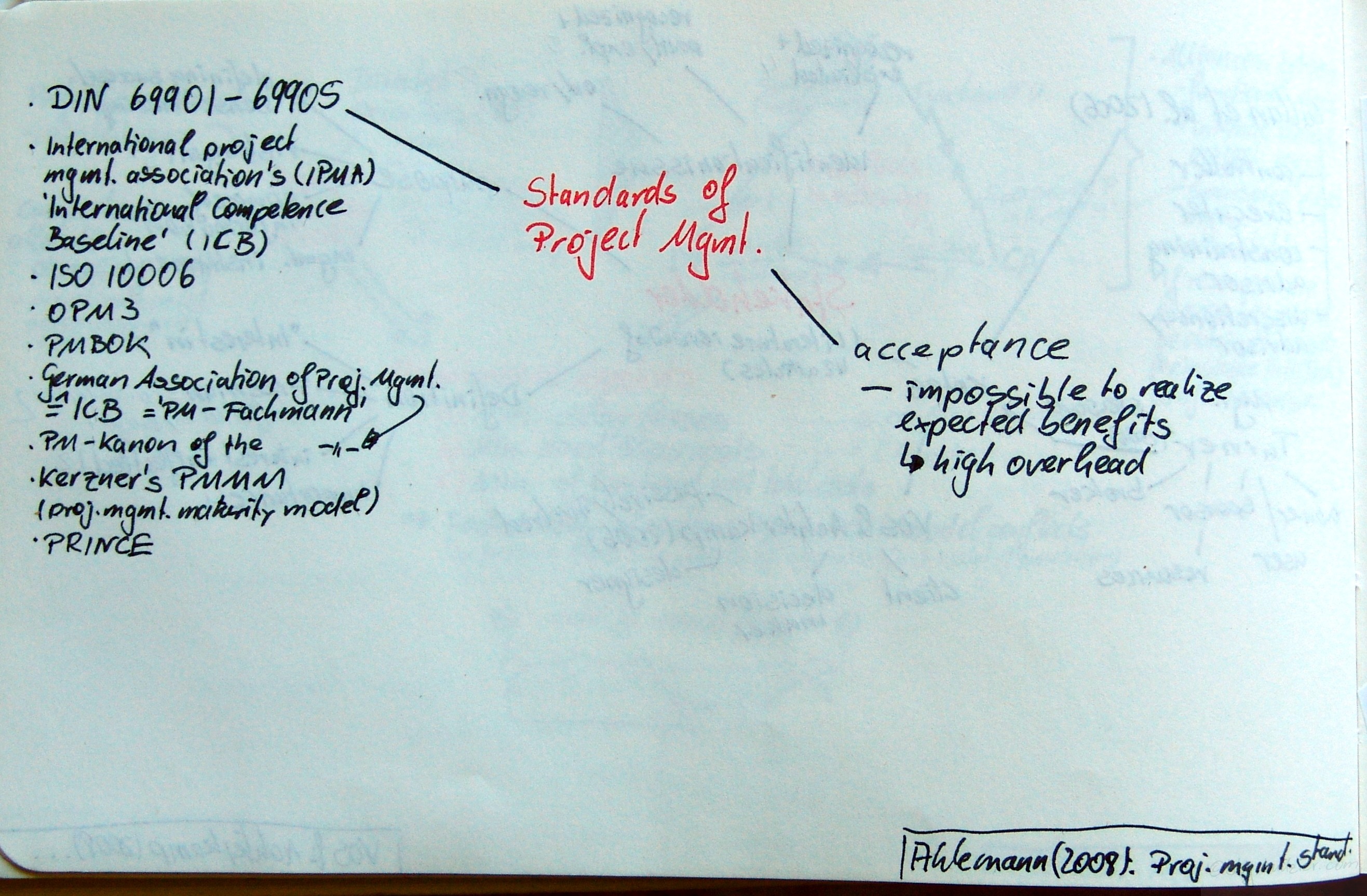 Ahlemann, Frederik; Teuteberg, Frank; Vogelsang, Kristin: Project management standards Diffusion and application in Germany and Switzerland; in: International Journal of Project Management, Article in Press, Corrected Proof.http://dx.doi.org/10.1016/j.ijproman.2008.01.009Update: This article has been published in: International Journal of Project Management, Vol. 27 (2009), No. 3, pp. 292303. This article discusses the use of standards and reasons behind that in detail. Instead of going in to these details I want to quickly focus on the more interesting aspects of this article, with three simple questions (1) Which standards do exist in the industry?, (2) What are the benefits of using them?, and (3) What holds us back?The standards used, and as such included in this survey, were
Ahlemann, Frederik; Teuteberg, Frank; Vogelsang, Kristin: Project management standards Diffusion and application in Germany and Switzerland; in: International Journal of Project Management, Article in Press, Corrected Proof.http://dx.doi.org/10.1016/j.ijproman.2008.01.009Update: This article has been published in: International Journal of Project Management, Vol. 27 (2009), No. 3, pp. 292303. This article discusses the use of standards and reasons behind that in detail. Instead of going in to these details I want to quickly focus on the more interesting aspects of this article, with three simple questions (1) Which standards do exist in the industry?, (2) What are the benefits of using them?, and (3) What holds us back?The standards used, and as such included in this survey, were
- DIN 69901 – 69905
- IPMA’s (International Project Management Association) International Competence Baseline (ICB)
- ICB’s German cousin the PM-Fachmann, and PM-Kanon
- ISO 10006
- OPM3
- PMBOK
- Kerzner’s Project Management Maturity Model (PMMM)
- PRINCE
What are the benefits of implementing and using a project management standards?
| Better communication/consistent terminology | Project stakeholders are able to communicate about project management aspects without friction. They experience that communication about project management issues becomes easier when there is a shared understanding of fundamental project management terms as expressed in a standard |
| Faster process implementation | (Compliant) project management processes can be planned and introduced faster than without a standard |
| Better process quality | Higher quality in terms of cycle times, process failures and achievement of objectives |
| Transfer of knowledge and best practices | Improvements of project management competencies |
| Better recognition by customers/marketing effects | Compliance as a cue of high project management competence for external stakeholders |
| Cost savings | Costs reductions for setting up and running the project management system |
| Better team play | More efficient project teams with better project results |
| Comparability with other internal organizational units | Standards allow benchmarking/comparisons of processes and results with other internal organisational units |
| Comparability with other external organizational units | Standards allow benchmarking/comparisons of processes and results with other external organisational units |
What holds us back in implementing project management standards in practice?
| Too theoretical | Standards are highly abstract and theoretical, such it cannot be understood easily and applied efficiently |
| Lack of flexibility | Standard not flexible enough for the requirements of a specific organization. Adaptation is either not foreseen or only hard to achieve |
| Not applicable to the specific implementation scenario | Standard is generally not applicable since its premises do not match the characteristics of the affected organisation |
| Costs of change | The costs of implementing the standard are too high |
| Administrational overheads | The operation requires too high administrative overhead |
| Lack of acceptance | The standard is not sufficiently accepted by staff members |
| Inefficient processes/practices | Standard requires inefficient processes or practices. Instead of improving process performance, cycle times and process costs rise |
The empirical results of this survey show that PMBOK is the most widely used standard in the sample. The second most commonly used standard is the ICB. Whereby the standard is rarely (in only 11% of cases) used as-is. Instead it is mostly adapted to the organisation or used as a pool of ideas.Secondly the list of benefits was tested against expectations before implementing standards and the captured benefits after the implementation. Expected benefits were
- Improvement of communication regarding project management issues
- Better process quality
- Faster implementation of project management processes
- Implementation of best practices
Of all benefits tested only the improvement of communications was taking place after implementing the standard.The authors identify lack of flexibility and adaptability as the major shortfall of standards. The main reasons for not applying a standard were
- High administrative overhead
- Lack of user acceptance
- High costs
ISO 9001 Audits…
In 1979, the British Standards Institution (BSI) developed the first commercial standard for quality systems that became known as BS 5750. That same year, BSI issued its first certificate to a small cement plant in England for compliance with BS 5750. …
statistical analysis…
The history of requirements for quality systems, or at least some elements of quality systems, goes back to pre-historic times. Almost 4,000 years ago, in the 18th century B.C., Hammurabi, the king of Babylonia, developed the first recorded code of law…
http://www.sangambayard-c-m.com